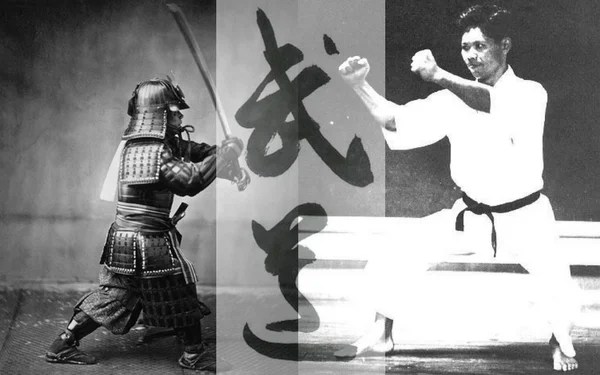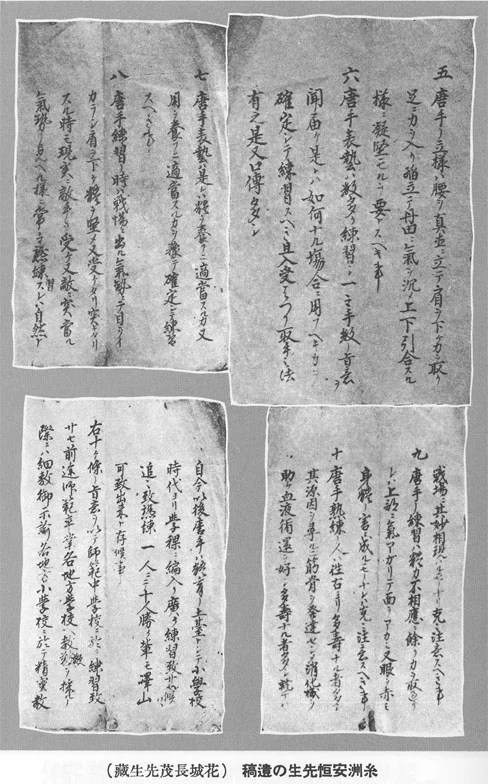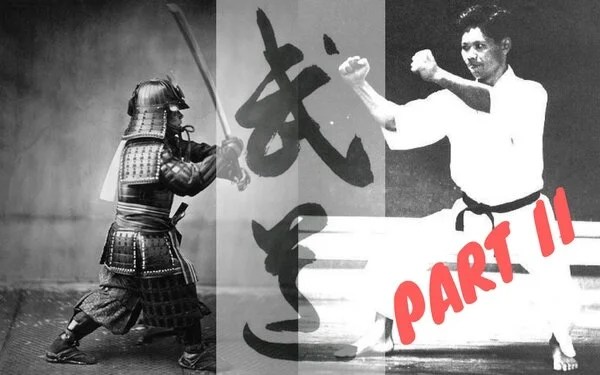
The Bu in question is the term for Warrior, as in Budō – Way of the Warrior. If you have trained in a Japanese style of Karate, even some Okinawan styles you will have heard this term at some point.
Either that your School offers to train you in Budō, that your training is consistent with Budō or that a certain way of training is identified as being Budō.
It is often associated with a sense of learning “traditional” Karate. I use these quotation marks for reasons that I will go into.
But first, let us take a step back in time….
In the year 1868 the Meiji Restoration took place on the Japanese mainland, and with it came the democritisation of its people and the removal of the class system that had prevailed for the previous 700 years – most notably the removal of the Samurai class and all its trappings.
Gichin Funakoshi was born at this time and even spoke of being told to remove his top knot in order to be accepted into medical school.
In 1879 the Ryukyu Royal Family were removed from power and Okinawa came to be ruled under the newly established Japanese government.
It was a time for Japan to modernise and to become more Western, so the old ways had to be removed.
However, the Samurai class, now seemingly dismantled from high positions of society actively sought to push their way of life onto the culture of Japan.
“It was not until the Meiji Restoration, when the Tokugawa regime was seemingly dismantled, that the samurai class was able to effectively project their ideological influence further afield than ever before by offering a viable way to the other subcultures of Japan to adopt the samurai lifestyle. As Ueno so elegantly puts it, “Democratization meant not the “commoner-zation “ of the samurai class, but the “samuraization” of the commoners” (Ueno 1987: S78).”
The elite of society were now allowing the lower classes to learn and practice their way of life, their philosophical outlook and their Martial Arts.
Enter the Dō
The Jutsu of the old Martial ways was deemed outdated and no longer of any use to a Government favouring a new Japanese Army which now trained in Western military tactics and the preference of guns over bows.
The Martial Arts were no longer for the battlefield but for the Dōjō, only now taught as personal self protection, as a way of tapping into the “traditional” culture, and as a sport.
As a means of spreading, and thus protecting, the old Martial Arts modern versions came into existence, the Jutsu was soon replaced by Dō, and a number of warrior practices were no longer taught as purely a form of combat, but a spiritual journey of self discipline and discovery. Extolled along with the adoption of the Warrior code.
The Warrior Code, or Bushidō, was promoted in the work of Nitobe Inazō’s 1900 publication of “Bushidō: The Soul of Japan”. Written in English, and later translated to Japanese, was primarily to aid in promoting Japan to western audiences.
It was this term, Bushidō, which originated in 17th century Japan, that came into common usage since Nitobe Inazō’s publication.
Much like the European creation of the “noble” knight, adhering to a set code of honour, so to did Japanese society become plunged into a rose tinted version of Samurai history – keenly taken up by the Japanese Army and the rising militarism of the country as Mark Ravina writes regarding the Hagakure:
“Rather than an account of samurai tradition, this work serves as an example of what the Japanese army thought Japanese soldiers should believe about samurai practice.”
Karate has entered the game
Karate, or at the time of the Meiji Restoration, Te, Toudi, was an Okinawan tradition that was now going to have to move with the times.
In the past it had evolved to weather the political changes of the Ryukyu Islands. Te was the term given to the traditional fighting form, which became mixed over time with other fighting arts of southeast asia, most notably Southern China.
It had perhaps grown from the weapons ban imposed by the first ruler of the Shō kingdom, further propagated by the ruling elite of Okinawa who serviced the Okinawan rulers with bureaucracy and protection.
It then survived during Satsuma control in the 17th Century either in secret or as was permitted to the ruling class of Okinawans charged with maintaining civil peace.
However, a different threat now came with the Meiji Restoration and it was left to the thinking of the Okinawan Te masters at the time as to the best solution; a solution that had occurred already on the Japanese mainland.
It is a telling point that Itosu Anko was aware of the changes being made across Japan and its outlying territories, and so I believe he worked to make changes in order to protect Karate,and in 1901 it become more inclusive and intertwined with the Okinawan School system.
This was before even that of Japan’s inclusion of Judō and Kendō into their respective School system in 1911.
The dangerous movements were hidden, the teaching of lethal applications were removed from the syllabus and in Itosu Anko’s letter, Tode Jukun (10 Precepts of Karate), dated October 1908, he writes to draw the attention of the Ministry of Education and Ministry of War in Japan:

“In the past, masters of karate have enjoyed long lives. Karate aids in developing the bones and muscles. It helps the digestion as well as the circulation. If karate should be introduced beginning in the elementary schools, then we will produce many men each capable of defeating ten assailants. I further believe this can be done by having all students at the Okinawa Teachers’ College practice karate. In this way, after graduation, they can teach at the elementary schools at which they have been taught. I believe this will be a great benefit to our nation and our military. It is my hope you will seriously consider my suggestion.”
Itosu even quotes the Duke of Wellington regarding how the battle of Waterloo was won firstly in the School playgrounds of Britain.
If you read the “Ten Precepts of Karate” you will also notice, in how I read it at least, a brushing aside of Karate’s Chinese roots.
In 1921 a display of Karate was presented to the Japanese Emperor Taishō and then in 1922 Gichin Funakoshi was requested to display Karate at the Tokyo Sports Festival; although arguably a number of Okinawans had in fact introduced the teaching of Karate on the Japanese mainland prior to this.
A number of prominent Japanese martial artists were introduced to Karate at this time and influenced various changes that were to make it more inclusive within Japan, with the approval of the growing military dominance in the country at the time.
Nishiyama, Ohtsuka, Kano, Konishi etc. were to add aspects of the other Japanese Martial Arts onto Karate, some of which was adopted into the Karate taught in Okinawa.
However, there was still a distinction between Karate on the Japanese mainland, and of that on Okinawa.
For me, this is where it gets really interesting.

Leave a comment